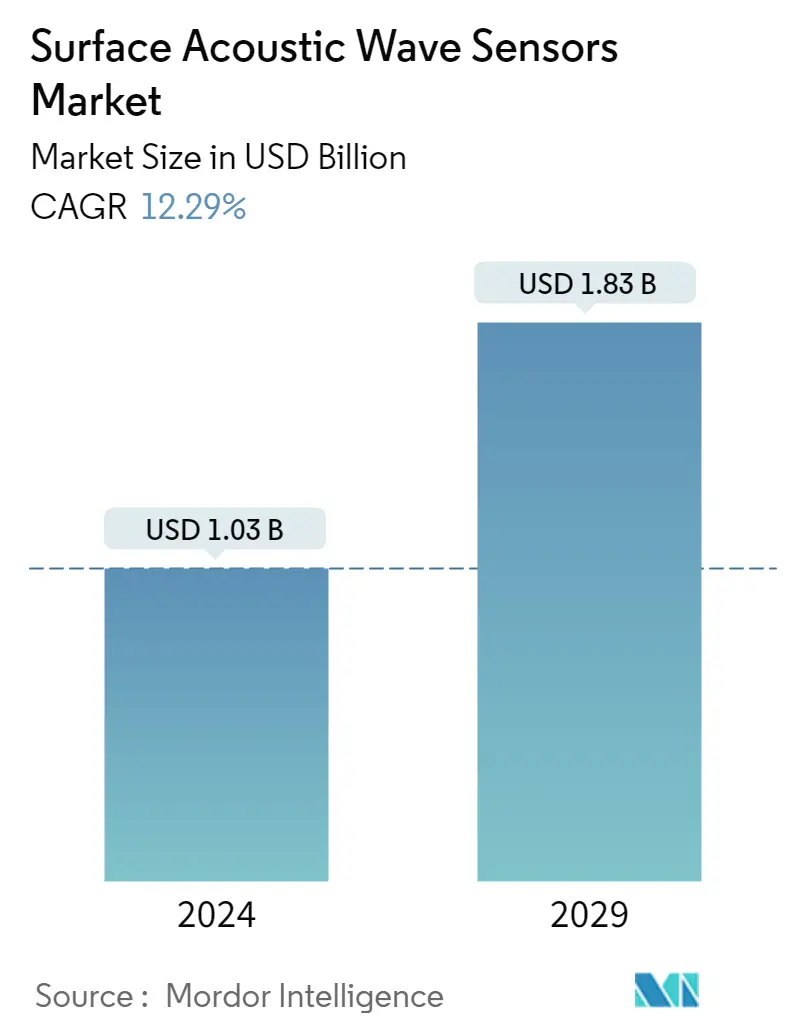Market Size of Surface Acoustic Wave Sensors Industry

| Study Period | 2019 - 2029 |
| Market Size (2024) | USD 1.03 Billion |
| Market Size (2029) | USD 1.83 Billion |
| CAGR (2024 - 2029) | 12.29 % |
| Fastest Growing Market | North America |
| Largest Market | Asia Pacific |
Major Players
*Disclaimer: Major Players sorted in no particular order |
Need a report that reflects how COVID-19 has impacted this market and its growth?
Surface Acoustic Wave Sensors Market Analysis
The Surface Acoustic Wave Sensors Market size is estimated at USD 1.03 billion in 2024, and is expected to reach USD 1.83 billion by 2029, growing at a CAGR of 12.29% during the forecast period (2024-2029).
Due to their small size, rugged nature, economical production, stability in operation, and applications across various end-user industries, the surface acoustic wave sensors make them an increasingly adopted sensor technology during the forecast period.
- Surface acoustic wave (SAW) technology has been significantly adopted across some industry applications, including aerospace, telecommunication, and automotive. The most common use is in electronic components known as SAW filters, a basic radio frequency (RF) circuit component. SAW devices have also been utilized to measure humidity, pressure, and temperature and detect certain chemicals.
- With advancements in the communication sector, SAW and bulk-acoustic-wave (BAW) resonators, filters, oscillators, and delay lines have gained traction. Apart from being passive and wirelessly interrogated, SAW sensors are competitively priced, intrinsically rugged, highly responsive, and intrinsically reliable.
- The automotive, defense, and aerospace industries are also attracting vendors in the market studied in recent years. As these sensors are insensitive to Magnetic Fields, many automotive applications require torque-sensing close to electric motors and solenoids. This is problematic for some other types of sensor technology.
- In the initial phase of COVID-19, the studied market witnessed a disruption in the supply chain owing to a nationwide lockdown and closure of many manufacturing capacities. However, after Q2 2020, the market started witnessing a recovery in demand and in production, the trend of the semiconductor industry was also reflected in the studied market. However, trends like electric vehicles and mandating safety features in automotive are increasing the per vehicle semiconductor content, which will help the SAW sensors demand to overcome the impact in the coming months.
- Researchers specializing in SAW sensors are actively seeking opportunities to partner with non-destructive testing solution providers in a bid to check the feasibility and ultimately open new application areas for these sensors. For instance, in partnership with NYIT's School of Engineering and Computing Sciences, the NDT solution provider for the aerospace and defense industry, X-Wave Innovations Inc., announced to work for NASA to develop an embedded sensor system capable of measuring temperature, pressure, and other stimuli affecting rocket propulsion engine systems. The project was also awarded funding of over USD 125,000 by NASA.
